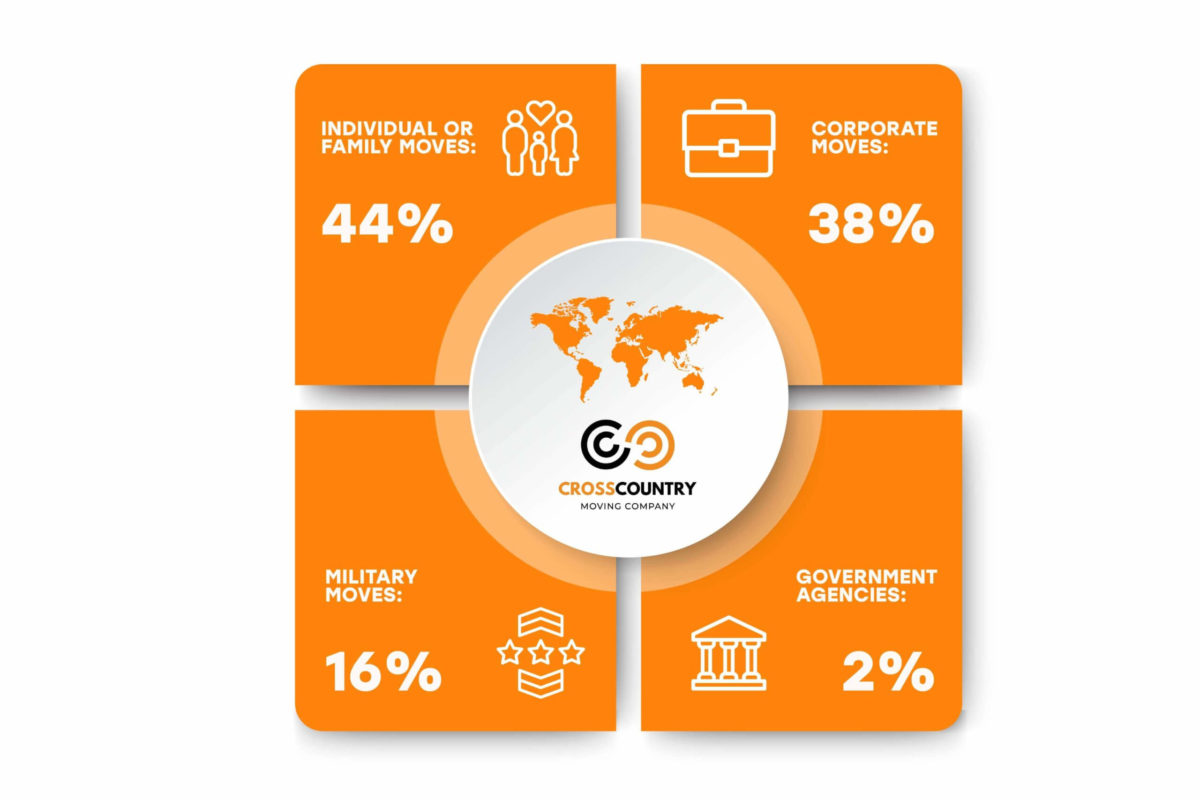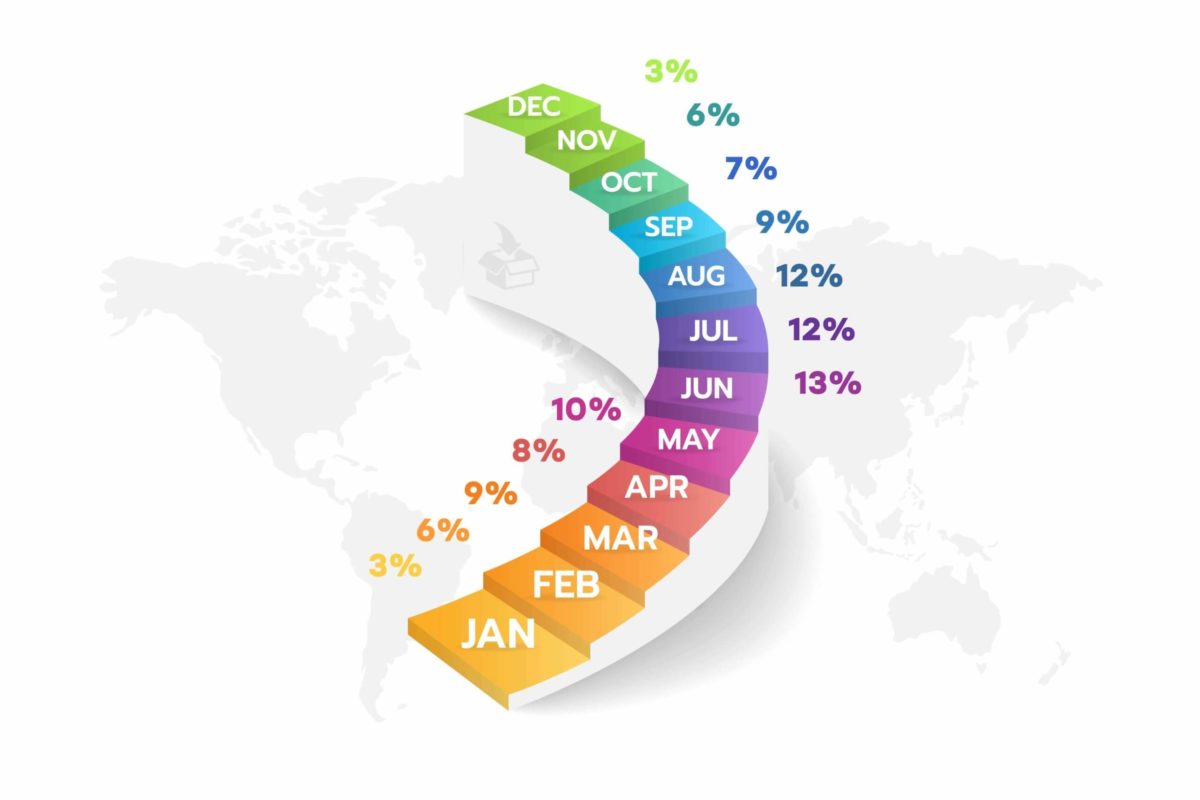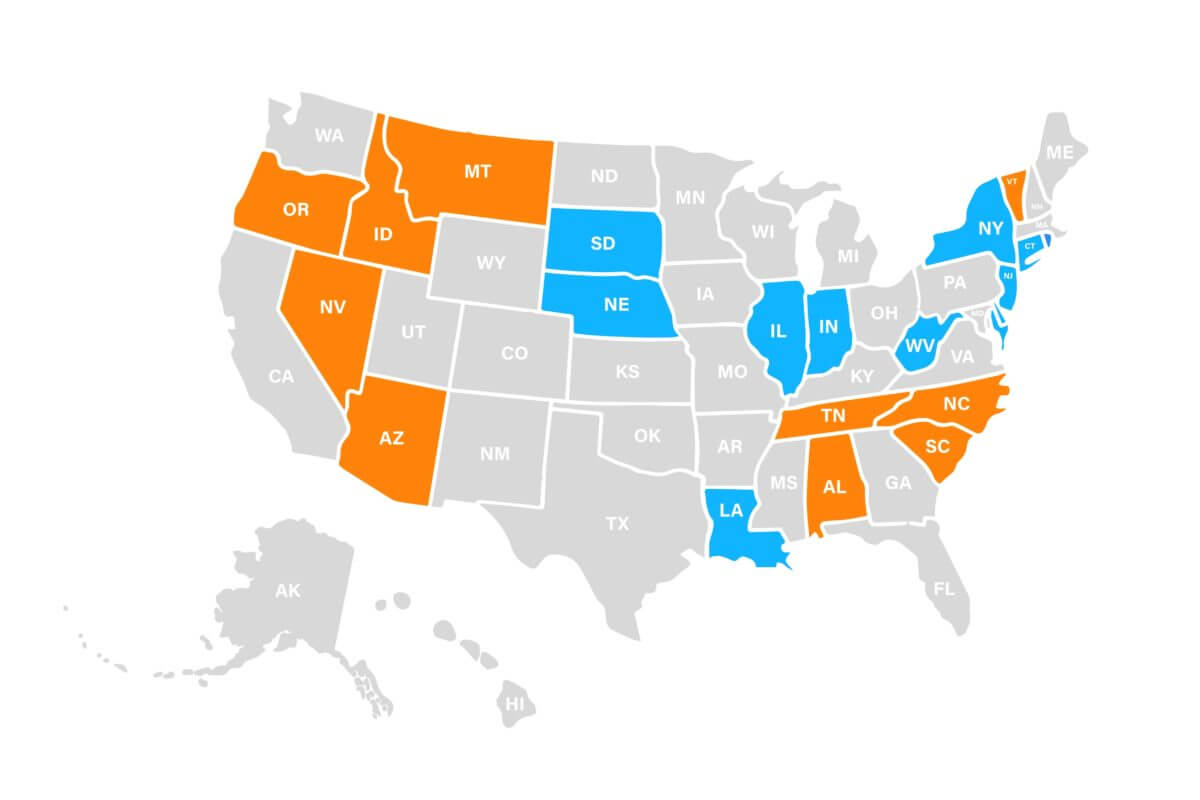Even with the pandemic looming over the world, many Americans decided to move, whether that’s because of income and employment change, eviction, or in pursuit of a safer place to live. If you are planning to do the same, before hiring professional assistance, check out the moving statistics for 2023 and gain some insight into the whole process.
Numbers don't lie, large number of people move each year. Who Moves Each Year According to Moving Statistics?
According to the US Census Bureau, roughly 10% of all Americans move each year. The data also states that the average mover is somewhere between 18 and 34 years old, and they are usually relocating with kids. It also shows that, as people get older, their tendencies to relocate go down. Also, renters tend to move more often than people who own a home.
If you are wondering what percentage of all moves are individual and what are corporate, military, and government ones, check out the chart below.
Most relocations during the year are individual. How Do People Move?
Informing friends that you are relocating or gently telling the parents that you are moving is just the beginning of the process. After that, it is time to decide if you should use a professional long-distance moving company to assist you or if you should DIY the whole thing. If you can’t make up your mind, take a look at how others decided to relocate.
Some people hire cross country movers, while others prefer to DIY the move. When It Comes to Relocation Industry Statistics, What Are the Sizes of Households People Move Most?
Household size shouldn’t stop you from relocating. It will play a role in figuring out how much packing materials you need, and it can impact the price of hiring long-distance movers. No matter if you are relocating a studio apartment or a five-bedroom house, you are not alone in your struggles. Check out the sizes of properties Americans move the most:
- Roughly 9.5% of all households are studio flats
- Approximately 29% of all moves are one-bedroom residences
- Two-bedroom homes with 21% come in second
- Three-bedroom residences make up 20% of moves
- Four or more bedroom homes make up roughly 8% of all relocations.
What Are the Most Commonly Moved Items?
When you start creating a photo inventory for insurance reasons, you might notice many things you don’t need or use anymore. Don’t try to bring everything with you. It is a relocation mistake that can cost you a lot of money, especially if you hire cross-country movers to assist you.
Play the relocation smart! Before booking cross-country moving services, take a closer look at your belongings and make an inventory list. This way, you’ll know which unwanted items to donate, what to sell, and what to throw away. Donating furniture and other items will greatly reduce relocation costs. Also, if you have some more valuable objects, consider using professional packing services.
Furthermore, if you want to move a shed or even ship a car, you can. Americans move a wide range of different items each year. If you are curious about what relocation essentials others ship, check out the data from American Moving and Storage Association (AMSA):
- 73% of people ship household objects
- 20% move electronics such as servers, computers, and fax machines
- 6% move art-related objects
What Time of the Year Do People Move the Most and When Do They Hire a Cross-Country Moving Company?
Most relocation industry statistics will vary depending on global economic and social trends. However, there are some that are resilient to change. One of those is the most popular time of the year when people relocate. US News & World Report states that relocation during summer is the most popular and that half of all moves happen between May and the beginning of September.
If you are hiring a cross-country moving company to help you relocate, but still want to find the cheapest way to move out of state, consider some of the less popular months. Check out the chart below and see the percentage of moves happening throughout the year.
Summer is the most popular time of the year for relocation. When creating your relocation budget, consider a winter move. Even though relocation during holidays and cold weather might seem like a really stressful process, the cross-country movers will be less busy, and it will be easier to book them. Also, to pick the best time of year to move, you should be aware of the most popular weekdays, and those are, according to statistics, Friday and Saturday. With all of this in mind, if you are looking for the cheapest time of year to move, book a relocation during winter in the middle of the workweek.
You can save a lot of money if you pick the right date for your relocation Relocation Statistics Basics – What Are the Top Reasons for Relocation in 2023?
There is no right or wrong answer when it comes to reasons to move, as long as you are sure of the decision and have a solid plan, everything else is less important. However, when it comes to relocation, you might feel anxiety about moving out, and you might start questioning the decision. If it starts to feel like relocation is more trouble than it is worth, check out the top reasons why others decided to relocate, and you might feel better about your move:
- Around 17.5% of Americans wanted a better, bigger, or new home
- 12% wanted to establish their own household
- Almost 11% of people got jobs that require relocation or a new employment
- 10.5% of people moved because of different family-related reasons
- Approximately 5% moved for a relationship or because of the change in marital status
- Roughly 3% of people wanted to live in a better and safer neighborhood.
Why People Are Moving During COVID-19
Relocation during a coronavirus global pandemic is not an impossible task, however, it requires additional caution. That being said, more than 15.9 million Americans relocated during the pandemic, according to data from the USPS. A study also showed that the main reasons why people decided to change their address during the coronavirus pandemic are:
- Fear of getting COVID-19
- Wanting to be closer to family members
- Closing of college campuses
- Financial reasons that include job loss.
Fear of getting Covid-19 was the main reason for the move last year. Let’s Look at Some Us Moving Statistics – What Are the Top States People Are Moving To?
Figuring out where should you move is probably one of the first things on your mind when deciding you need a fresh start. Finding the right place to put down some roots will take time and a lot of research. Depending on your needs and desires, there will be plenty of places you can settle in. However, US moving statistics show that some states are more popular than others. That’s why, if you are not sure what place would be best for you, check out what are the most popular states according to data from AMSA:
- North and South Carolina
- Arizona
- Idaho State
- Tennessee
- Oregon
- Nevada
- Alabama
- Vermont State
- Montana
All of these states have something to offer to newcomers. No matter if you want to move to a big city or if you are dreaming about living in the suburbs, there will be a place to call home. While some states are gaining residents, there are some that are rapidly losing population. According to the Census Bureau, those are:
- New York State
- State of Indiana
- Connecticut
- South Dakota
- Nebraska
- Louisiana
- Delaware
- West Virginia
- State of Illinois
- New Jersey
Some states are gaining population while others are rapidly loosing it. What Do Moving Industry Statistics Show, What Are the Most Popular Cities to Move to in 2023?
If knowing the most popular states to live in doesn’t narrow down your search, then maybe you should focus on the most popular cities in the US. Data from USPS and Census Bureau shows that some cities saw an increase in inbound relocation. Some of those are:
- Relocating to Austin, Texas can be a great idea
- If your heart is set on Texas, you can also move to Dallas
- You can be one of those that relocated to Denver in pursuit of happiness
- Relocating to Miami is losing its appeal, but places like Tallahassee, Tampa, and Orlando are steadily gaining residents
- If you want to settle in Tennessee, consider Nashville and Knoxville
- Spokane Washington is also very attractive to newcomers
- Finally, if you’re going to settle in Nevada, consider Las Vegas or Reno.
We’ve Looked at the Cross-Country Moving Companies, but What Are the Moving Trends When It Comes to International Relocation?
International relocation is also an option to think about. After all, around ten million Americans are living outside of the US, according to the State Department. Almost 40% of them are either in Canada or in Mexico. Luxembourg and Qatar have recorded the greatest gain of American citizens in the last few years. Furthermore, 40% of Americans chose to retire abroad, while roughly 39% relocated for love.
Miami is just one of the cities that's gaining popularity How Much Does a Relocation Cost? Plan the Budget Before Employing Cross-Country Movers
The price of relocation depends on many factors, such as the amount of stuff, distance, and whether you are DIYing the move or hiring professionals to assist you. If you opt for handling everything on your own, you’ll be faced with the huge responsibility of organizing everything. Obtaining packing materials will be the first cost, and it will depend on the number of objects you are bringing to a new location. Next, there is the price of renting the truck, buying gas, and many different smaller costs along the way.
If this seems like more trouble than it is worth, hiring a cross-country moving company is the solution. However, before you actually hire professionals, research and call a few companies. This way, you’ll avoid becoming a victim of a relocation scam. While researching, you’ll learn how much movers cost for a one-bedroom apartment, as well as any other household size you are interested in.
Since the prices depend on many factors, it is almost impossible to say what the average prices of relocation are. However, when you do the research, it will be easy to tell which company will keep your things safe but, at the same time, won’t completely drain your bank account.
There is no way to tell precisely how much the relocation will cost. What Kind of Moving Industry Trends You Should Keep an Eye on in the Future?
The United States has a population of more than 328 million people spanning roughly 3.8 million square miles, meaning that no relocation market in the world comes close to it. There are many relocation companies offering a wide array of long-distance moving services, which results in steady market growth.
Moving industry statistics from the last few years show a rise in revenue and the number of relocation companies. Furthermore, the industry shows a growth in the number of employees. Even with the pandemic of COVID-19, the predictions say that the relocation industry will only continue to grow in the years to come.
Frequently Asked Questions About Moving Statistics
What Is the Most Popular Destination for Movers in the US?
The most popular destination for movers in the United States is likely to be a state with a large population and diverse job opportunities. According to data from Zillow, the top five states for relocation include Florida, Texas, California, North Carolina, and Arizona.
How Many People Move Each Year in the US?
Each year, millions of Americans move to a new home or city within the United States. According to the U.S. Census Bureau, approximately 28 million people moved in the 12-month period ending in December 2021.
What Distance Do Most People Move Within a Year?
According to the United States Census Bureau, most people move within the same county or about 50 miles or less from their current residence. However, this doesn’t mean that people don’t move across the country from the east to the west coast and vice versa.
What Age Group Is Most Likely to Move?
When it comes to the whole moving across the country process typically, young adults in their 20s and 30s are the most likely to move.
What Are the Statistics Related to the Frequency of Moving?
The frequency of long-distance moving can vary depending on a number of factors such as age, income, job location, and personal preferences. However, according to the United States Census Bureau, on average, Americans move about 11.7 times in their lifetime. In terms of yearly frequency, the US Census Bureau also reports that approximately 10 to 15 percent of the population moves each year. However, this rate can vary depending on the specific region or state within the United States. For example, some states have a higher rate of mobility, such as Nevada and Florida, while others have a lower rate, such as Vermont and Maine. Additionally, younger adults tend to move more frequently than older adults, with the highest rates of mobility occurring between the ages of 18 and 34.
How Many People Move in the United States Each Year?
According to data from the United States Census Bureau, approximately 10 to 15 percent of the US population moves each year. This translates to around 32 million Americans who move annually. However, it’s important to note that this number can vary from year to year and across different regions of the country. In recent years, the COVID-19 pandemic has also had an impact on the frequency of cross-country moving, with some studies suggesting that fewer people may be moving due to economic uncertainty and other challenges associated with the pandemic. Nonetheless, moving remains a common occurrence for many Americans, with a significant number of individuals and families relocating each year for various reasons, such as work, family, or lifestyle changes.
What Are the Reasons People Move, and What Do the Statistics Show?
People move for a variety of reasons, including employment opportunities, housing needs, family reasons, and lifestyle changes. According to the US Census Bureau, employment-related reasons are the most common reasons for cross-country moving, with approximately 47 percent of movers indicating that they moved for job-related reasons in recent years. Other common reasons for long-distance moving include family-related reasons (such as marriage or divorce), housing-related reasons (such as upgrading or downsizing), and lifestyle-related reasons (such as seeking a better climate or better schools).
The reasons for cross-country moving can also vary depending on demographic factors, such as age, income, and education level. For example, younger adults may be more likely to move for employment opportunities, while older adults may be more likely to move for family-related reasons.
How Far Do People Typically Move During a Relocation, and What Is the Average Distance for a Move?
The distance people typically move during a relocation can vary based on a variety of factors, such as the reason for the move and the distance between the origin and destination locations. However, according to the US Census Bureau, the average distance for a move within the United States is approximately 1,000 miles. About 64 percent of moves are within the same county, 17 percent are to a different county within the same state, and 19 percent are to a different state.
Additionally, the average distance for long-distance moves (those that cross state lines) is approximately 1,200 miles. Of course, these figures are just averages, and individual moves can vary significantly in terms of distance, depending on the specific circumstances of the move.
What Percentage of People Move for Work or Job-Related Reasons?
According to data from the US Census Bureau, job-related reasons are the most common reasons for cross-country moving, with approximately 47 percent of people indicating that they moved for work or job-related reasons in recent years. This can include moving for a new job opportunity, a job transfer, or being closer to a current place of employment. Job-related moves can be more common among younger adults who are just starting their careers or who may be more willing to relocate for better job opportunities. However, job-related moves can also be a factor for individuals at all stages of their careers who are seeking new opportunities or who need to relocate for their current job.
What Is the Average Cost of a Long-Distance Move in the United States, and How Does It Compare to Local Moves?
The average cost of a long-distance move in the United States can vary depending on the distance of the move, the number of belongings being moved, and other factors such as whether additional cross-country moving services like packing and unpacking are needed. However, according to the American Moving and Storage Association, the average cost of a long-distance move in the United States is around $4,300. In comparison, the average cost of a local move is around $1,250, which is significantly less expensive due to the shorter distance and time involved. It’s important to note that these are just averages, and individual long-distance moving costs can vary significantly based on the specific circumstances of the move.
How Many People Move With the Help of a Professional Moving Company?
According to the American Moving and Storage Association, approximately 35 million Americans move each year, and of those, approximately 11-13% hire a professional moving company to help with their move. This translates to roughly 3.85 to 4.55 million people each year who use professional cross-country movers.
Hiring a professional cross-country moving company can help make the long-distance moving process easier and less stressful, particularly for those relocating their whole households or moving cross-country. Professional movers can provide a range of long-distance moving services, including packing and unpacking, loading and unloading, and transportation of belongings. However, it’s important to carefully research and compare cross-country moving companies to ensure that you choose a reputable and reliable cross-country moving service.
What Percentage of People Who Move Experience Problems or Issues During the Process?
Long-distance moving can be a complex and challenging process, and it’s not uncommon for people to experience problems or issues during a move. According to a survey conducted by the Better Business Bureau, approximately 42 percent of people who moved in the past two years reported experiencing some type of problem or issue during the cross-country moving process. Common issues included damaged or missing belongings, delayed delivery, and issues with payment or fees.
It’s important to carefully research and choose a reputable cross-country moving company to help minimize the risk of problems or issues during a move. Additionally, taking steps such as creating an inventory of belongings, purchasing appropriate insurance coverage, and carefully reviewing contracts and agreements can also help to reduce the likelihood of issues arising during the cross-country moving process.
What Are Some of the Common Challenges People Face During a Move, and How Can They Be Addressed?
Moving can present a range of challenges and obstacles, from logistical issues to emotional stress. Some common challenges people face during a move include:
- Packing and unpacking belongings: Packing and unpacking can be time-consuming and overwhelming, particularly for larger moves. To address this, consider hiring a professional cross-country moving service, or breaking the process down into smaller, manageable tasks over a longer period of time.
- Transportation of belongings: Moving furniture and other large items can be a challenge, especially for long-distance moves. Consider hiring a professional long-distance moving company to handle transportation.
- Adjusting to a new environment: Moving to a new place can be emotionally difficult and require an adjustment period. Try to establish a routine and explore the new area to become more comfortable.
- Cost of the move: Cross-country moving can be expensive, with costs associated with packing, transportation, and any necessary storage. Consider creating a budget for the move, and research options to save money, such as moving during off-peak times.
- Disorganization and miscommunication: Disorganization and miscommunication can lead to delays, lost items, and other issues during a move. To address this, create a detailed long-distance moving plan, keep communication lines open with any involved parties, and keep important documents and information in a central location.
How Do Moving Statistics Vary by Age, Income, and Other Demographic Factors?
Moving statistics can vary significantly depending on demographic factors such as age, income, and education level. For example, younger adults tend to move more frequently than older adults, with the highest rates of mobility occurring between the ages of 18 and 34. Additionally, people with higher levels of education and income may be more likely to move for job-related reasons or for lifestyle changes, such as seeking a better climate or cultural opportunities.
Regional factors can also play a role, with some states and cities experiencing higher rates of mobility than others. For instance, cities with a booming job market may attract more young professionals, leading to higher rates of in-migration. Overall, demographic factors can significantly impact moving patterns and the reasons people choose to relocate.














